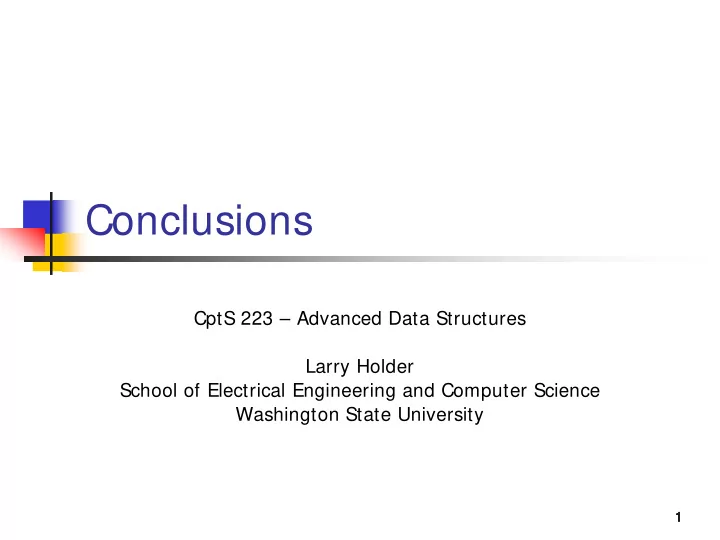

Conclusions CptS 223 – Advanced Data Structures Larry Holder School of Electrical Engineering and Computer Science Washington State University 1
Course Overview Advanced data structures Trees, hash tables, heaps, disjoint sets, graphs Algorithm development and analysis Insert, delete, search, sort Applications Object-oriented implementation in C+ + 2
Analysis Tools Counting primitive operations Exponents, logarithms and summations Analyzing recursive solutions Recurrence equations: T(N) = 2T(N/2) + Θ (N) Proof by induction and contradiction Rate of growth notation: O, Ω , Θ Summarizes analysis Eases comparison among solutions 3
Performance 4
Object-Oriented Design in C+ + Encapsulation: Class = Data + Methods Information hiding Hiding implementation details Operator overloading Perform familiar operations (< , = = ) with complex elements Templates Design data structures independent of element type Standard Template Library (STL) 5
Basic Data Structures Lists, stacks, queues O(1) insert/delete O(N) search STL: vector, list, stack, queue 6
Advanced Data Structures Trees Binary search tree O(log N) insert, delete and search Balanced BST: AVL and Splay Massive trees: B-tree STL: set, map 7
Advanced Data Structures Hash tables O(1) insert and search Collision resolution Chaining, Open addressing Good hash functions, probe sequences Rehashing Extendible hashing STL+ : hash_set, hash_map 8
Advanced Data Structures Heaps (Priority Queues) Keep elements partially ordered Heap = complete binary tree O(log N) insert, delete (worst-case) O(1) insert (average-case) Mergeable heaps: Binomial heap STL: priority_queue 9
Advanced Data Structures Disjoint sets Implement equivalence class operations Find and Union Tree representation Union by rank Path compression O(1) find, union (average-case) 10
Advanced Data Structures Graphs Adjacency list vs. adjacency matrix Algorithms Breadth-first search (BFS): O(V+ E) Depth-first search (DFS): O(V+ E) Topological sort (DFS): O(V+ E) Shortest path: O(E log V) Maximum flow: O(E 2 log V) Minimum spanning tree: O(E log V) Biconnectivity and articulation points (DFS): O(V+ E) Euler circuits (DFS): O(V+ E) Strongly-connected components (DFS): O(V+ E) 11
Algorithm Design 12
Algorithm Design and Analysis: Sorting Comparison sorts Linear sorting Insertion sort Counting sort Merge sort Bucket sort Heap sort External sorting Quicksort Lower bound: Θ (N log N) 13
Algorithm Design and Analysis: Sorting Sort Worst Average Best Comments Case Case Case Θ (N 2 ) Θ (N 2 ) Θ (N) InsertionSort Fast for small N Θ (N log N) Θ (N log N) Θ (N log N) MergeSort Requires memory Θ (N log N) Θ (N log N) Θ (N log N) HeapSort Large constants Θ (N 2 ) Θ (N log N) Θ (N log N) QuickSort Small constants 14
Hard Problems I nput Size 10 20 30 40 50 60 vs. Complexity n .00001 s .00002 s .00003 s .00004 s .00005 s .00006 s n 2 .0001 s .0004 s .0009 s .0016 s .0025 s .0036 s n 3 .001 s .008 s .027 s .064 s .125 s .216 s n 5 .1 s 3.2 s 24.3 s 1.7 min 5.2 min 13.0 min 35.7 366 2 n .001 s 1.0 s 17.9 min 12.7 days years centuries 2x10 8 1.3 x 10 13 3855 3 n .059 s 58 min 6.5 years centuries centuries centuries 15
Classes of Hard Problems All Problems NP-Hard NP Difficulty P NP-Complete Does P = NP ? 16
NP-Complete Problems The hardest problems in NP Prove problem is NP-Complete by “reducing” known NP-Complete problem to it Determining the class of a problem helps us know the best performance we can achieve Approximation algorithms 17
Applications Operating systems Compilers Databases Route planning Dictionary/symbol lookup Molecular analysis Image processing Theory of computation Many more … 18
Problem-solving 19
Summary Moral Appropriate data structures ease design and improve performance Challenge Design appropriate data structure and associated algorithms for a problem Analyze to show improved performance PLEASE FILL OUT YOUR ON-LINE COURSE EVALUATION!! 20
Recommend
More recommend